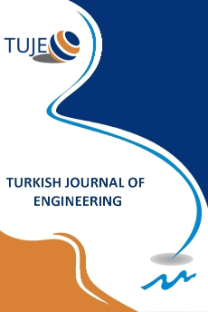AN INTEGRATED APPROACH BASED ON THE TAGUCHI METHOD AND RESPONSE SURFACE METHODOLOGY TO OPTIMIZEPARAMETER DESIGNOF ASBESTOS-FREE BRAKE PAD MATERIAL
___
Aleksendrić, D., Barton, D.C. (2009). “Neural network prediction of disc brake performance.” Tribology International, Vol. 42, No. 7, pp. 1074-1080.Aleksendric, D., Duboka, Č. (2006). “Prediction of automotive friction material characteristics using artificial neural networks-cold performance.” Wear, Vol. 261, No. 3-4, pp. 269-282.
Anoop, S., Natarajan, S., Babu, S.K. (2009). “Analysis of factors influencing dry sliding wear behaviour of Al/SiC p–brake pad tribosystem.” Materials & Design, Vol. 30, No. 9, pp. 3831-3838.
Asiltürk, I., Akkuş, H. (2011). “Determining the effect of cutting parameters on surface roughness in hard turning using the Taguchi method.” Measurement, Vol. 44, No. 9, pp. 1697-1704.
Bijwe, J., Aranganathan, N., Sharma, S., Dureja, N., Kumar, R. (2012). “Nano-abrasives in friction materialsinfluence on tribological properties.” Wear, Vol. 296, No. 1-2, pp. 693-701.
Djafri, M., Bouchetara, M., Busch, C., Weber, S. (2014). “Effects of humidity and corrosion on the tribological behaviour of the brake disc materials.” Wear, Vol. 321, No. 1, pp. 8-15.
Ertan, R., Yavuz, N. (2010). “An experimental study on the effects of manufacturing parameters on the tribological properties of brake lining materials.” Wear, Vol. 268, No. 11-12, pp. 1524-1532.
Ficici, F., Durat, M., Kapsiz, M. (2014). “Optimization of tribological parameters for a brake pad using Taguchi design method.” Journal of the Brazilian Society of Mechanical Sciences and Engineering, Vol. 36, No. 3, pp. 653-659.
Gurunath, P.V., Bijwe, J. (2007). “Friction and wear studies on brake-pad materials based on newly developed resin.” Wear, Vol. 263, No. 7-12, pp. 1212-1219.
Kukutschová, J., Roubíček, V., Mašláň, M., Jančík, D., Slovák, V., Malachová, K., Filip, P. (2010). “Wear performance and wear debris of semimetallic automotive brake materials.” Wear, Vol. 268, No. 1-2, pp. 86-93.
Kumar, K.R., Mohanasundaram, K.M., Arumaikkannu, G., Subramanian, R. (2012). “Analysis of parameters influencing wear and frictional behavior of aluminum–fly ash composites.” Tribology Transactions, Vol. 55, No. 6, pp. 723-729.
Mutlu, I. (2009). “Artificial neural network modelling of non-asbestos brake lining performance boric acid in brake pad.” Information Technology Journal, Vol. 8, No. 3, pp. 389-402.
Myer, R.H., Montgomery, D.C. (2002). Response surface methodology: process and product optimization using designed experiment, John Wiley and Sons, New York, USA.
Phadke, M.S. (1995). Quality engineering using robust design, Prentice Hall PTR, Upper Saddle River, NJ, USA. Sagbas, A., Kahraman, F., Esme, U. (2009). “Modeling and predicting abrasive wear behaviour of poly oxy methylenes using response surface methodolgy and neural Networks.” Metalurgija, Vol. 48, No. 2, pp. 117- 120.
Singh, K.H., Kumar, A., Kumar, R. (2014). “Optimization of Quality and Performance of Brake Pads Using Taguchi’s Approach.” International Journal of Scientific & Engineering Research, Vol. 5, No. 7, pp. 632-639.
Sugözü, İ. (2015) “Investigation of using rice husk dust and ulexite in automotive brake pads.” Materials Testing, Vol. 57, No. 10, pp. 877-882.
Sugozu, I., Can, I., Oner, C. (2014). “The effect of borax on the friction performance of an automotive brake lining.” Materials Testing, Vol. 56, No. 5, pp. 362-368.
Sugozu, I., Can, I., Oner, C. (2014). “Investigation of using Calabrian pine cone dust and borax in brake pads.” Industrial Lubrication and Tribology, Vol. 66, No. 6, pp. 678-684.
Sugozu, I., Mutlu, I., Sugozu, K.B. (2016). “The effect of colemanite on the friction performance of automotive brake friction materials.” Industrial Lubrication and Tribology, Vol. 68, No. 1, pp. 92-98.
Sugozu, I., Mutlu, I., Sugozu, K.B. (2018). “The effect of ulexite to the tribological properties of brake lining materials.” Polymer Composites, Vol. 39, No. 1, pp. 55- 62.
TS 555 (1992). Highway Vehicles-Brake System-Brake Pads for Friction Brake, Turkish Standard Institute, Ankara, Turkey.
Xiao, G., Zhu, Z. (2010). “Friction materials development by using DOE/RSM and artificial neural network.” Tribology International, Vol. 43, No. 1-2, pp. 218-227.
Yadav, R.N. (2017). “A hybrid approach of TaguchiResponse Surface Methodology for modeling and optimization of Duplex Turning process.” Measurement, Vol. 100, No. 1, pp. 131–138.
Zaharudin, A.M., Talib, R.J., Berhan, M.N., Budin, S., Aziurah, M.S. (2011). “Taguchi method for optimising the manufacturing parameters of friction materials.” Proceedings of Regional Tribology Conference, RTC, Langkawi Island, Malaysia, pp. 246-251.
- ISSN: 2587-1366
- Yayın Aralığı: 4
- Başlangıç: 2017
- Yayıncı: Mersin Uüniversitesi
MASS CONCRETE CONSTRUCTION USING SELF-COMPACTING MORTAR
İ. Raci Bayer, Lutfullah Turanli, P. Kumar Mehta
MECHANICAL AND WEAR CHARACTERISATION OF QUARRY TAILINGS REINFORCED A6063 METAL MATRIX COMPOSITES
Stephen Durowaye, Olatunde Sekunowo, Babatunde Bolasodun, Isaac Oduaran, Ganiyu Lawal
DETERMINATION OF MALIGNANT MELANOMA BY ANALYSIS OF VARIATION VALUES
Veysel Alcan, Ahmet Kürşat Esim, Hilal Kaya
USER-ORIENTED FILE RESTORATION FOR OPERATING SYSTEMS
MODELLING AND OPTIMIZATION OF THE EXAM INVIGILATOR ASSIGNMENT PROBLEM BASED ON PREFERENCES
PREDICTINGTHE ENERGY PRODUCTIONOF A ROOFTOP PV PLANT BY USING DIFFERENTIAL EVOLUTION ALGORITHM
